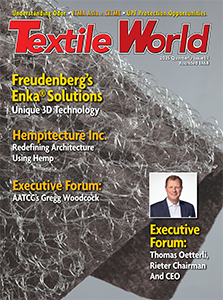SUWANEE, Ga. — February 14, 2018 — Mimaki USA, a manufacturer of wide-format inkjet printers and cutters, today announced the availability of Tiger-1800B printing system in the Americas. The Tiger-1800B printer is a purpose-engineered, high production digital inkjet printer capable of direct-to-textile or transfer dye sublimation output. It can deliver large-scale production at manufacturing sites and small-scale production at on-demand sites, making it the ideal printer for digital textile applications.
The Mimaki Tiger-1800B brings operational efficiencies and reliability to large companies that are currently using analog screen-printing processes — or multiple, smaller digital units — to produce high volume textile runs for internal vertical markets sold via business-to-business or business-to-consumer avenues. The Tiger-1800B printer enables these businesses to overcome quality, cost and time to market issues by offering more efficient operations, higher resolution printing, consistent quality for repeat orders, and reduced operating costs.
The 74.8-inch Tiger-1800B digital textile printer includes an adhesive belt transport system with belt washing technology and in-line heat drying unit for an all-in-one process for direct-to-textile printing. It includes a built-in PC with software for easy and efficient printer operation.
High efficiency for all production runs
The Tiger-1800B printer is a production model featuring 16 print heads in a staggered array for the direct-to-textile model (or 8 print heads for the transfer dye sublimation model), resulting in very high print speeds of up to 4144 square feet per hour. Usable quality can be achieved even at these high print speeds to meet volume demands, or to quickly produce shorter-run projects such as for regional or seasonal fashion requirements.
High print speeds are complemented by a sophisticated textile transport system. Stable textile transport is achieved through twin pressure roller shafts attached to the edge of the transportation belt. Textiles are uniformly transported onto the belt through the rollers.
Wrinkle and Media Jam sensors detect textile wrinkling or creasing early in order to minimize potential damage to the print heads from collisions with raised or jammed textiles.
Technologies for improved performance and productivity
The Tiger-1800B model includes a number of technologies and automated processes for consistent quality output and productivity.
A belt washing mechanism that prevents stains on fresh fabric from ink remaining on the belt. It is equipped with two squeegees to prevent splash-back, and two heaters to dry and re-activate the belt surface.
To ensure optimal print head maintenance, cleaning liquid is automatically applied to each wiper before and after head cleaning. This liquid enhances the head cleaning process and reduces daily maintenance time by ensuring a clean wiper.
The Tiger-1800B printer features Variable Dot Printing where variable ink droplet sizes — small, medium and large — are precisely placed. Smaller droplets create smoother gradients and quartertones, while large droplets produce uniform solids.
A standard Degassing Module reduces clogging by removing air bubbles in the ink, and an Ink Circulation ensures stable ink supply by constantly circulating the ink.
Optional high production upgrades
Options for the direct-to-textile model include: Roll Media Centering Unit featuring a feeding unit with a centering device and tension bar; a Jumbo Roll Unit; a Plaited Unit; and a Drying and Take-Up Unit for high density printed fabrics. The dye sublimation model includes the Jumbo Roll Unit as a standard feature.
Posted February 15, 2018
Source: Mimaki USA




